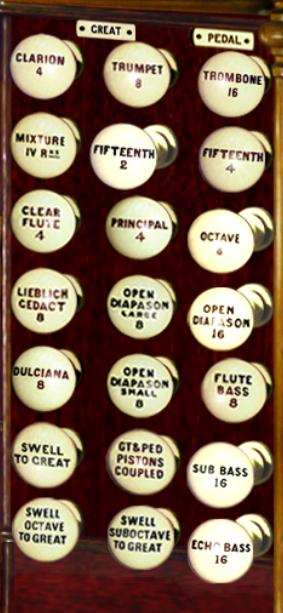

Fun With Wind Modelling
2015-05-29 - Hauptwerk TechnicalNow that everyone has the wind modelling system in their version of Hauptwerk, it's time to have some fun with it.
I Have Wind Modelling. What Does This Mean?
One of the things that takes Hauptwerk to a whole different level of authenticity, when compared to your average digital organ, is the wind modelling system. Wind sag is one of the hallmarks of a living, breathing, dynamic pipe organ experience. The subtle variations in tone and pitch bring a sense of richness and movement to the sound. It's just missing in 99% of the digital/virtual instruments out there (yeah. I made up that statistic... but I'm sure it's close). However, having it makes a wonderful difference to the sound.
You can actually find real wind modelling in another digital organ technology, but the cost will be several hundred times the cost of Hauptwerk. So, let's test Hauptwerk's out in an indisputable way !
Holy Anne's Moseley!
I'm sure there are many sample sets you can try this on. However, the only one that I can guarantee that you all have is St. Anne's Moseley.
So, try this. Pull out the Open Diapason 16, Sub Bass 16 and Echo Bass 16 on the pedal. Pull the Fifteenth 2 on the Great.
Play a C maj chord on the Great starting at C5 and hold it. While holding the C maj chord, play C1 and C2 simultaneously on the pedals in 8th or 16th notes (depends what tempo marking you're using :) ).
You will hear fluctuations in the notes of the C maj chord. If you keep doing it, you may even hear a light "chirping" effect. Personally, I find it's easier to hear if you have someone else play it while you're just listening. I'm too busy concentrating on doing the movements to devote my full attention but you're more coordinated than me I'm sure.
Other tests
Some third-party organs have switches to turn the virtual blower off/on
(giving a 'shot bagpiper' effect as the wind drains out of the reservoirs!). I used to do this with the MDA Wet Skinner set because it was super fun. You just turn the key off after it's been running a while and keep playing. Unfortunately, MDA organs no longer have those switches since they caused so much support from users accidentally turning the blower off and then not understanding why it wasn't working.
I haven't played with many of the others to see which other ones do it. If you have a set that has a blower on/off switch, give it a go. Or, if you never updated the original MDA E.M. Skinner ODF like me (yippee), try it out. Nothing will convince you more about the wind system than hearing that.
For those who can't do this on their own, you can listen to what I call "Wagner the Bagpiper Gets Shot - a wind model demonstration"
Black Magic?
How does all of this work? I've got no idea. Just thank whomever you thank in these situations for Martin Dyde. Be thankful that he finds wind modelling and depletion algorithms fascinating.
So What Can You Tell Me?
What I can tell you is that Hauptwerk sample sets are constructed the way an organ builder would look at constructing an organ.
I get calls to consult on new organ construction all of the time. I can tell immediately if it's the organist who is calling or if it's a builder who is calling by listening for where they start as a point of reference. If they start with the console, it's an organist. If they start with the chamber, they're a builder. It's not that the console is irrelevant to a builder. It's just that all the magic really happens in the chambers. The organist is usually blissfully insulated from what goes on in the chamber.
Hauptwerk sample sets start with the chamber and that's a good thing. It means you're getting the real deal.
The size of the chests are calculated, the number of chests, the number of pipes on a chest are needed, the location and sizes of pipes on each chest are considered, the pressure of the wind is set, airflow randomization, direction and distance the bellows move, mass of the moving board, the relative weighting of wind supply to each chest, and tons more factors that, frankly, I don't understand.
Hauptwerk even models the rate at which the chests leak when not being used. How crazy is that?!
So, when you are buying a digital re-creation of a historic pipe organ, this is what you're getting. There are is at least one sample set out there where the real instrument has been added to so much that it's under-winded. You can actually hear the instrument sag when you pull out a lot of stops. It was so good that, when we took it to an organ builders' convention, that was one of the main things that won them over.
What Martin has done, in Hauptwerk, is beyond impressive. I'm not even sure what the appropriate word would be for what he's accomplished. However, as one conservative, organ-world celebrity dubbed it, upon sitting down to play Hauptwerk at our trade show booth, this is "Scary Good".
So, may the wind be always at your back and in your Hauptwerk instrument.
Comments
However, there may be some other improvements and/or bug fixes in 4.2 that would make it worth your while to upgrade.
Note that wind modelling is only available in the Advanced Edition